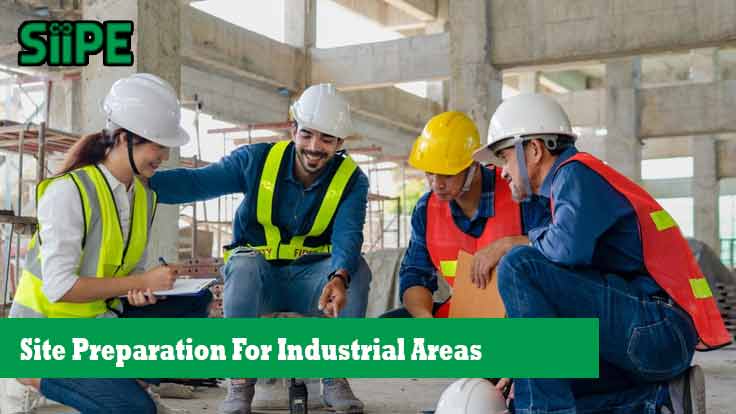Site preparation is one of the most crucial phases in the development of industrial areas. It lays the foundation for all subsequent construction work and ensures that the site is ready for efficient, safe, and sustainable operations.
Without thorough and proper preparation, industrial developments can face costly delays, environmental hazards, and infrastructure issues that hinder productivity and profitability.
In this article, we will explore the steps involved in site preparation for industrial areas, highlighting the importance of each phase, challenges to anticipate, and best practices for a successful outcome.
1. Site Selection and Feasibility Studies
The first step in site preparation begins long before the construction phase. It starts with selecting the right location for the industrial facility. The chosen site must meet specific criteria, such as proximity to transportation networks (roads, railways, ports), accessibility to utilities (water, electricity, gas), and zoning regulations that allow industrial use.
Feasibility studies play a pivotal role in assessing the suitability of the site. These studies evaluate factors like soil conditions, topography, climate, environmental impact, and the local infrastructure’s capacity to support industrial development. Any issues identified at this stage can save considerable time and money in the future.
2.Land Surveying and Geotechnical Analysis
Once a site is selected, it is essential to conduct a detailed land survey and geotechnical analysis. This process involves evaluating the soil’s composition, stability, and load-bearing capacity. The results help determine whether the land is suitable for the intended industrial structure and whether any additional groundwork, such as soil reinforcement, is needed.
Surveying also maps out the boundaries of the property and identifies natural features (rivers, wetlands, slopes) that could impact the construction process. Understanding the topography and the underlying geology allows engineers to develop a comprehensive design for the industrial area.
3. Clearing and Grading
After the survey and analysis are complete, the site is prepared by clearing and grading the land. This involves removing any existing vegetation, trees, structures, or debris from the site. Excavation work may also be required to level the ground or remove any obstacles that could impede the construction process.
Grading ensures the land is at the correct slope and elevation for construction. Proper grading allows for effective drainage, preventing water from pooling on the site and reducing the risk of flooding. A well-graded site also improves the overall layout and accessibility of the industrial area.
4. Environmental Impact Assessment and Mitigation
Environmental considerations are crucial when preparing a site for industrial development. Before any major construction can begin, an environmental impact assessment (EIA) must be conducted. This assessment evaluates the potential effects of the proposed project on the surrounding environment, including air, water, and soil quality, as well as wildlife and natural habitats.
If the EIA identifies any significant environmental risks, mitigation strategies must be implemented. These may include the installation of waste treatment systems, water filtration, or noise barriers to reduce the impact on local ecosystems and communities. By addressing environmental concerns early in the site preparation phase, developers can avoid costly regulatory fines and delays.
5. Utility and Infrastructure Installation
For an industrial area to be functional, it needs essential utilities like water, electricity, and gas. Site preparation includes coordinating the installation of these utilities. This could mean extending existing utility lines to the site or constructing new infrastructure to meet the industrial area’s needs.
Electrical power is crucial for machinery, lighting, and HVAC systems, while water supply is needed for both production processes and employee facilities. Gas lines may be necessary for heating or powering certain equipment, depending on the type of industry. Additionally, telecommunications infrastructure should be considered for data and communication systems.
The availability and capacity of local utilities should be checked beforehand to ensure that they can support the industrial operations without issues. This also includes ensuring that there is adequate waste management infrastructure, such as sewage systems, stormwater management, and recycling facilities.
6. Transportation and Access Roads
Transportation access is another key factor in site preparation. Industrial areas must be connected to major highways, railways, and possibly ports for the movement of goods and materials. Developing or upgrading access roads is essential to ensure smooth logistics operations.
Roads leading to the industrial site need to be built to handle heavy traffic, especially for industries requiring large shipments or frequent transport. The construction of access roads includes clearing the land, laying down gravel or asphalt, and ensuring proper signage and traffic control.
For larger industrial developments, rail connections may also be necessary. Rail systems offer an efficient method for transporting bulk materials and products, and setting up rail spurs to connect the site to regional or national networks can provide long-term cost savings for manufacturers.
7. Stormwater Management and Drainage Systems
An essential element of site preparation is planning and implementing stormwater management systems. During construction, heavy rains can cause significant runoff that may damage the site or neighboring areas. A well-designed drainage system helps direct rainwater away from industrial buildings and roads, preventing flooding and soil erosion.
In many areas, local regulations require stormwater management plans that adhere to specific standards. Developers must design systems that can handle both short-term and long-term runoff, taking into consideration the local topography and climate.
8. Site Security and Fencing
Security is an often-overlooked aspect of site preparation but is crucial for protecting the industrial facility, its assets, and workers. Fencing around the perimeter of the industrial area is a standard method of ensuring safety and deterring unauthorized access. Additionally, security features such as surveillance cameras, controlled access points, and lighting may be necessary to protect the site from theft or vandalism.
For sites located in high-risk areas or near sensitive infrastructure, extra security measures, such as guardhouses and fencing with security sensors, may be required.
9. Compliance with Local Regulations and Permits
Throughout the site preparation process, it is essential to comply with local regulations and obtain the necessary permits. This includes zoning permits, construction permits, environmental permits, and health and safety clearances. Failure to comply with regulations can result in delays, fines, or even the suspension of construction work.
Developers must work closely with local authorities to ensure that all aspects of the site preparation meet legal requirements and safety standards.
10. Risk Management and Contingency Planning
Finally, risk management is a crucial component of site preparation. Developers should have contingency plans in place for unexpected issues, such as adverse weather, soil instability, or delays in utility installation. Risk management strategies help minimize the impact of unforeseen events and ensure that the development proceeds smoothly despite any challenges that arise.











